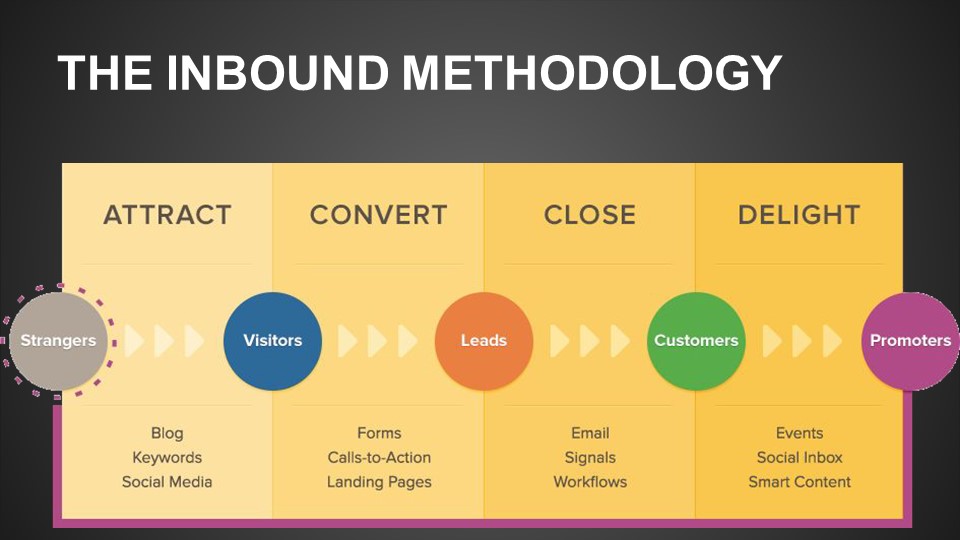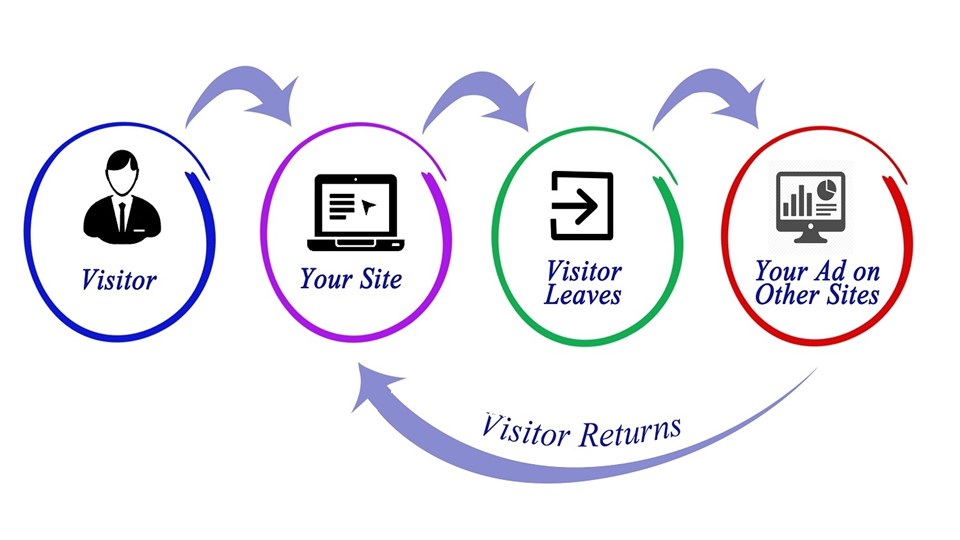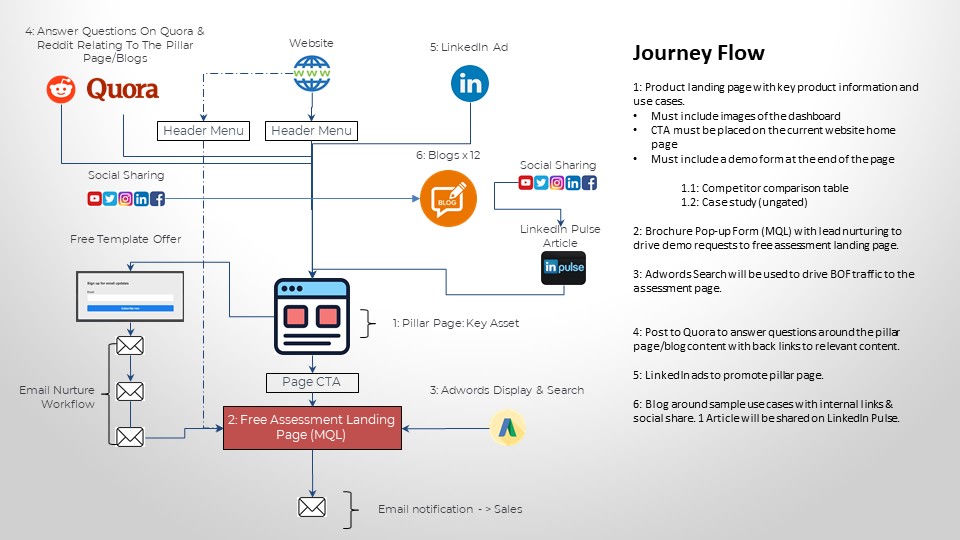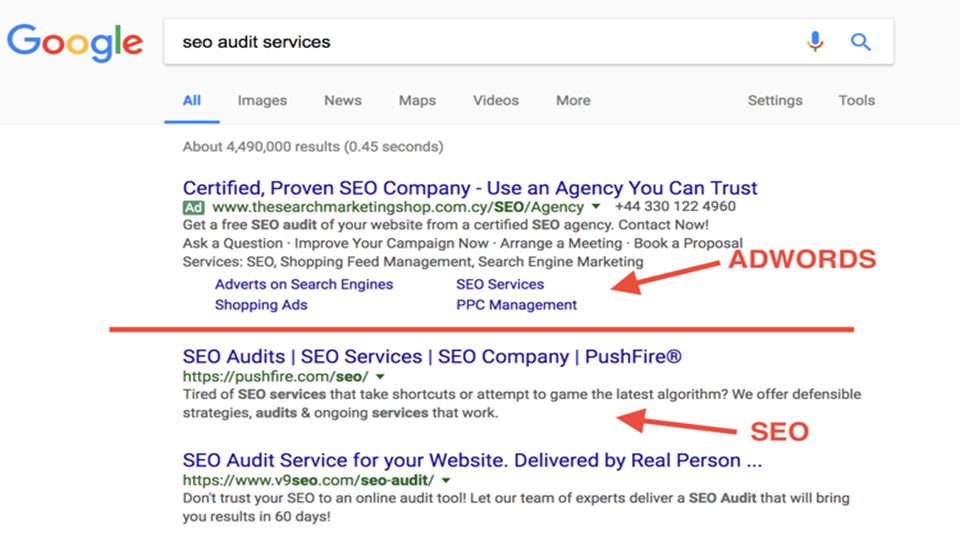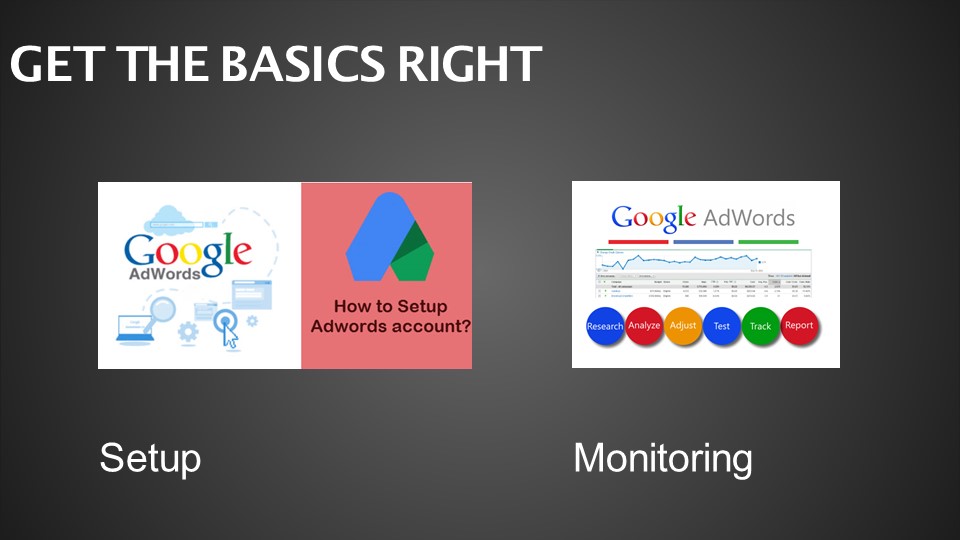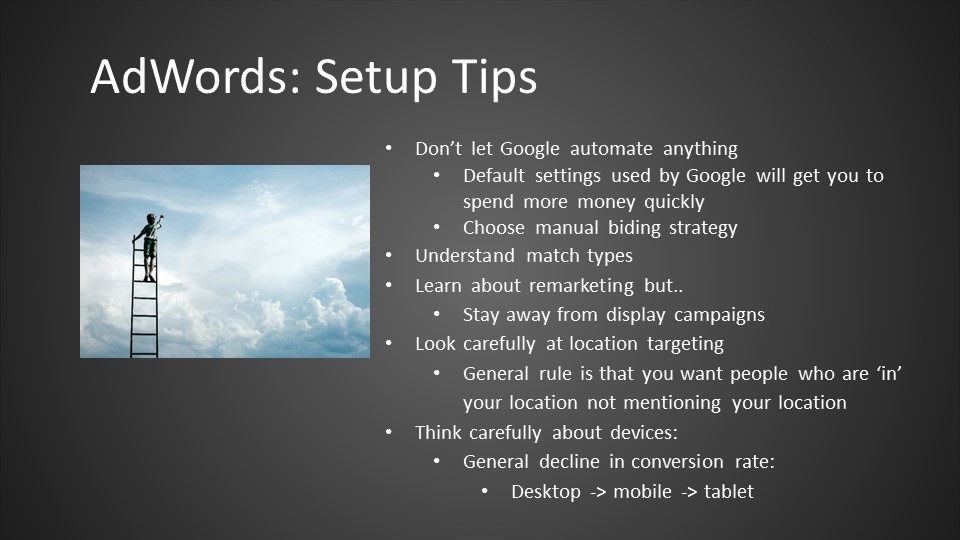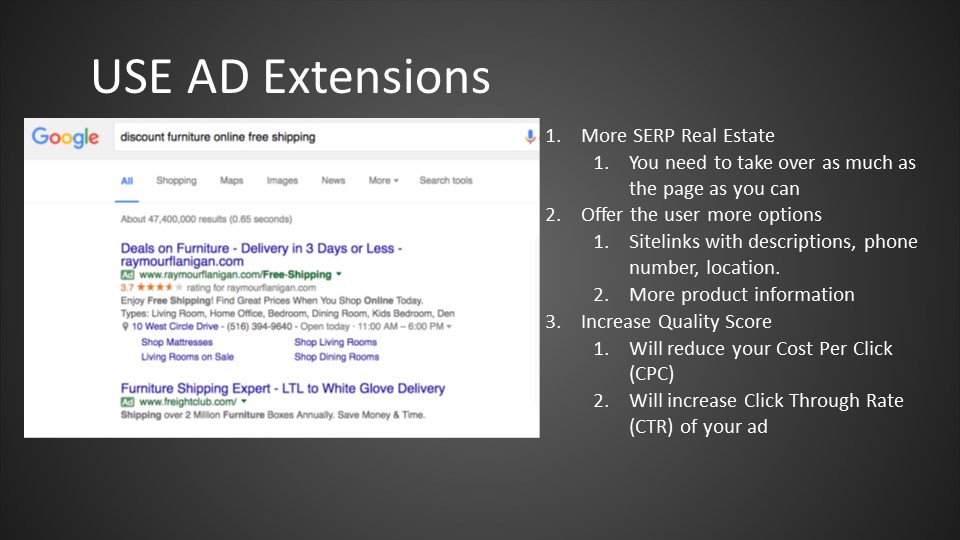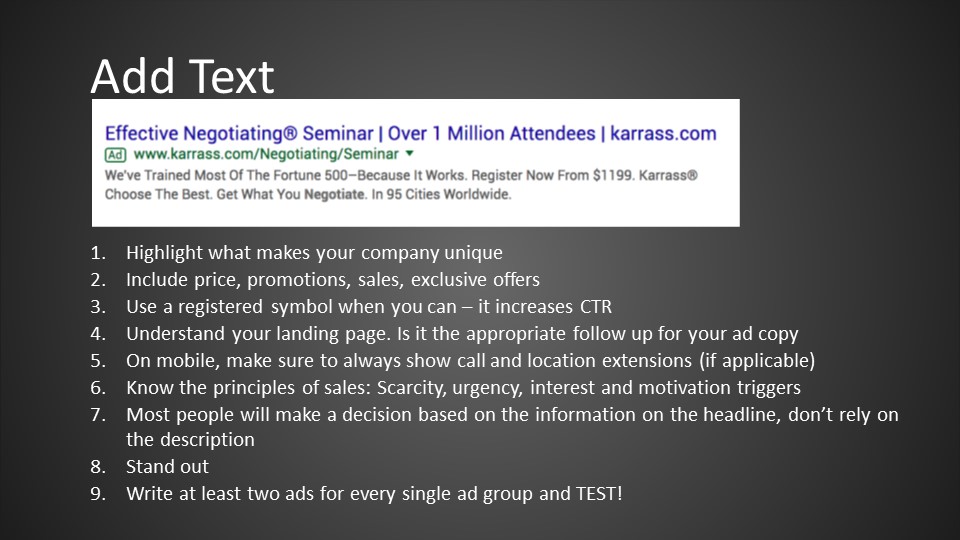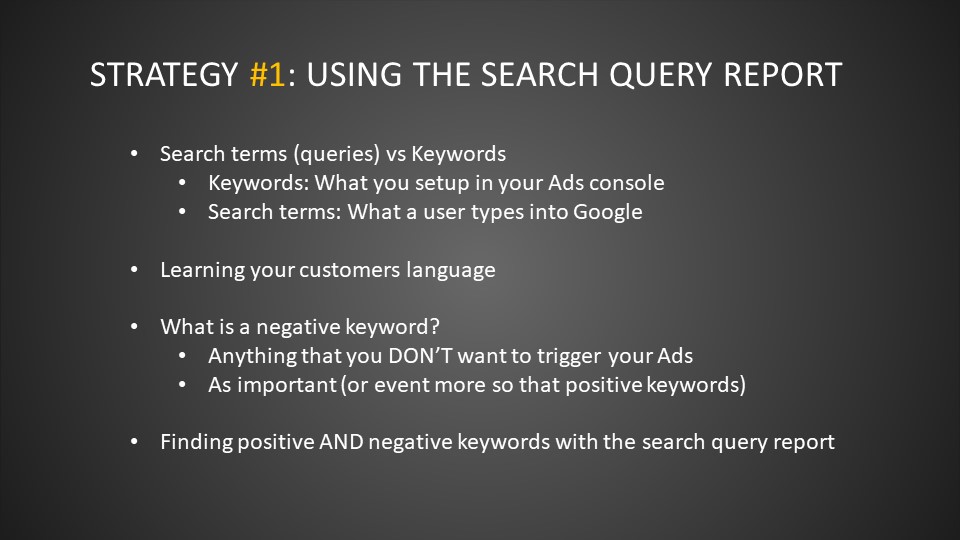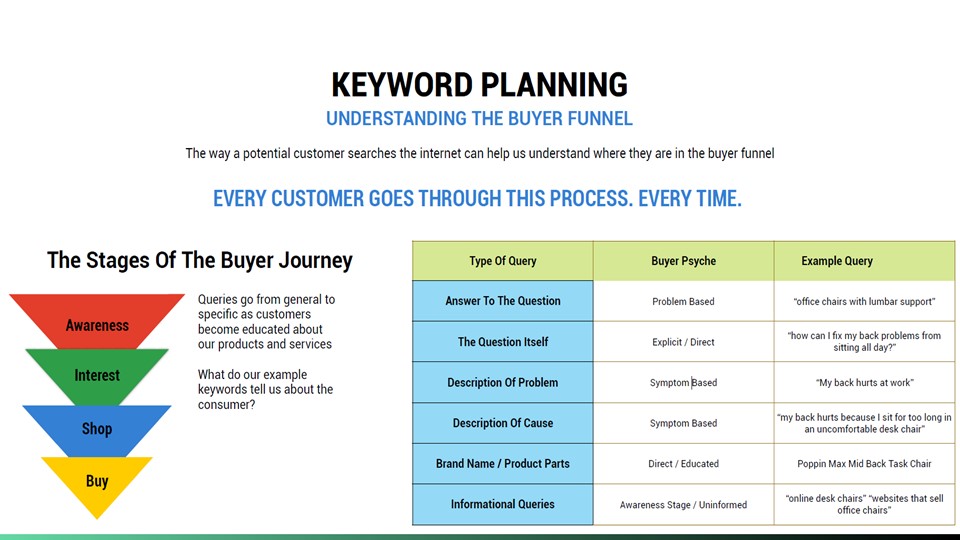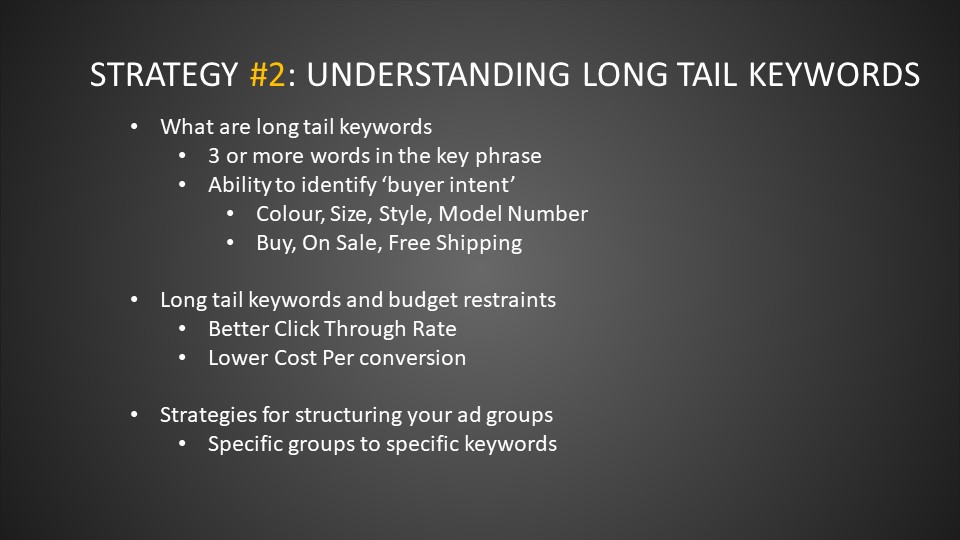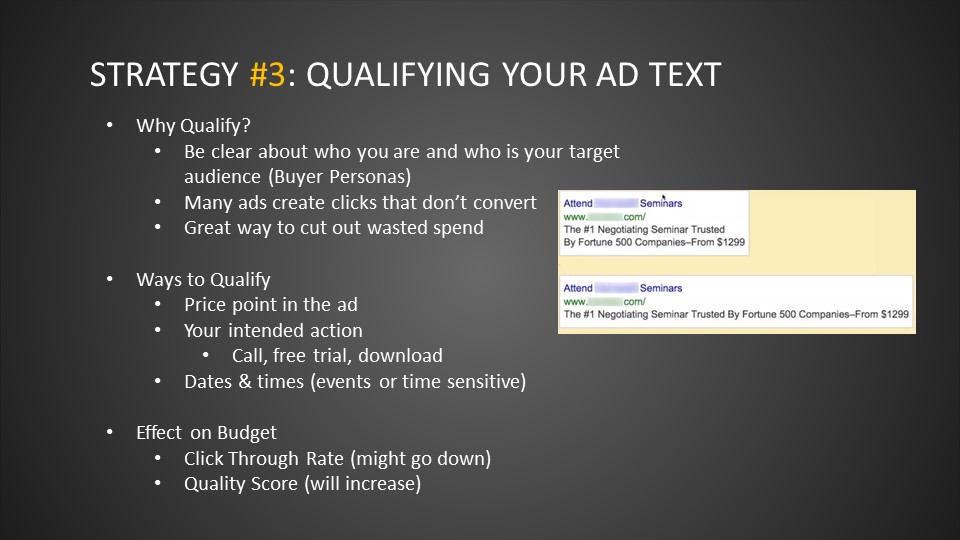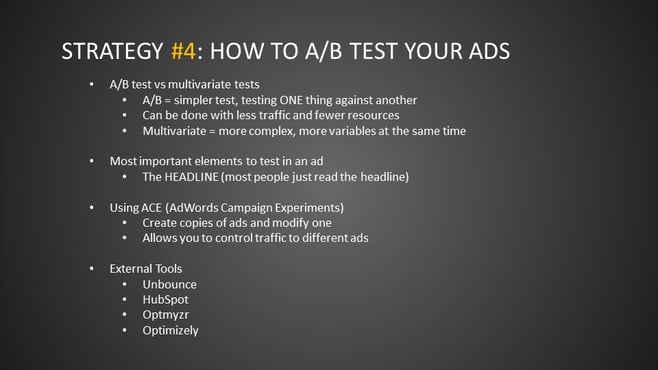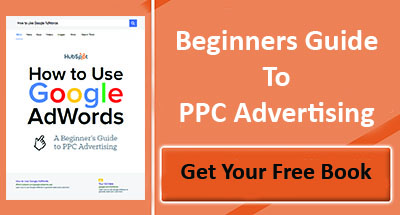4 Google AdWords Strategies For Companies On A Shoestring Budget
- Home
- 4 Google AdWords Strategies For Companies On A Shoestring Budget
We're going to look at managing Google AdWords, which is an interesting topic since it’s something that's not really talked about a huge amount in the inbound world. It's only really more recently become part of the HubSpot world because in many ways paid advertising is almost seen as the wrong thing to do, right?
It's not very “inbound-y”, as our American cousins would say.
The reason for that is that most advertising is interruptive. It's getting in the way of people trying to do what they're doing naturally. But, specifically, AdWords is not necessarily like that. It is responding to a particular user's query when they're searching on Google and it is returning a result. The only difference is that you are paying for the right to appear on those results pages.
Inbound Marketing and Paid Ads
Inbound is an approach focused on attracting customers through content and interactions that are relevant and helpful. If you're going to put an ad in front of somebody and you're going to send them through to a landing page, then it's really, really important that it is relevant and helpful.
There are so many instances of paid campaigns that we review and analyse that are just really, really bad. It's pay and pray and hope that if I could just get somebody to my website, they will understand my vision, my meaning and everything else. Everything goes to the homepage and suddenly they wonder why nobody is actually making any money.
Let’s remind ourselves of the inbound methodology: attract, convert, close and delight.
The paid campaigns typically sit within the attract phase, but more and more they can actually sit at other points of the buyer's journey. This came home to me the other day when I was at HubSpot in Dublin and they were talking about a new piece of functionality that they're rolling out called the attribution report model, which is available on the Enterprise level.
Single-Point vs. Complex Attribution Report Models
This is really interesting because attribution reporting is key to all of the things that we do as marketers. When we talk about closing a deal, when we talk about generating a lead, we tend to think of those things as single points – you know, the lead came from LinkedIn or the lead came from an organic campaign. What we don't really realise is that those leads have multiple touch points through the buyer's journey. If you have single point attribution – that is, you allocate your closed deal to organic search, for example – you're missing out on the fact that that prospect engaged with your brand multiple times. They might've seen you on social, they might've clicked on a paid ad, or they might've read a blog post, but there's other things that might have had a really important impact.
If you look at complex attribution models, what you actually tend to see is that although a lead might come through from organic, they will be brought back to the website and back to the company through, perhaps, a remarketing campaign. Remarketing, therefore, is not seen as something that either generates leads or closes leads, but something that's a cost centre that we’re spending money that’s not actually helping. However, if you look at it in the attribution model world, you'll see that 80% of the touch points go through some paid at some point or other, which means that they're very valuable. If you were to cut them out, your conversion rates down the funnel will fall.
What I want you to take away from this is not just how to run a PPC and an ad campaign and do it well and do it within budget, but to look at it within the context of an actual inbound campaign.
AdWords and Inbound Campaigns
So, what does an inbound campaign actually look like? It comprises of multiple different components.
You've got website components, like a pillar page. You've got a blog. You've got social sharing of the blog posts. You've got LinkedIn going through Pulse. You've got interactions through things like Reddit and Quora. You've got nurturing campaigns from template offers. You've got assessment pages. You've got email verification, and you’ve got AdWords. All of these things work together.
Unless you're seeing the whole thing in the context of the entire campaign that needs the entire journey flow, then you're really missing out on a lot of different ways that you can improve the lead gen flow through your organisation. What I want to do is just focus on this little bit – paid campaigns. But why would I do that if we're doing all of this other stuff and we've got writers creating content and all these different things?
Well, people who know me know that I'm an SEO expert. It's one of the things that we've been doing forever. And if anybody asked me a question, the answer is SEO. But it isn't quite true, right? Organic traffic can take quite a considerable amount of time to build and in a competitive marketplace it can take a lot of money and effort to beat out the competition.
So if you have just started, you've gone through that whole process – you've defined all of your different workflows, you've created your download pages and you've published your first blog – and suddenly nothing happens, that's frustrating. That's when senior management start talking about return on investment spends and that's when you start having some very difficult conversations with your clients.
The same thing is actually true on social. You can put out both paid and organic work through social, but social tends to work in spikes. People have very short attention spans. Even if things get through influencers, driving traffic can actually only be a blip. Businesses are always looking for a quick return on investment and paid campaigns can do that. They drive the initial traffic and they can validate that workflow.
This is why actually as a search engine optimisation strategy, paid can be really, really useful because you can test, you can experiment, and you can try different things out. You can find out what keywords, phrases and topics are really resonating with your audience. More importantly, you can actually find which ones convert better. Rather than waiting 12 or 18 months for an organic campaign to eventually get you number one for that magic keyword, and then you find the conversion rates are terrible, why don't you throw some paid money at it and see whether it actually works? And it can happen very, very quickly.
There's lots of different ways of paying to generate traffic to your site. They're all valid, but the biggest one is still Google AdWords. All of them are relevant, with some of them more relevant for the different buyer personas that your businesses have.
What is Google AdWords?
Just so we know what we're talking about, when you go to Google and you type something in, the first few results are paid ads. These ads used to stand out, and there used to be some sort of side ads as well. Those are the massive, great banners. If you look at that now, it's actually quite difficult to see what is an ad and what is not an ad, and this is predominantly because this is how Google makes its money. It wants you to pay to have those ads put in place and it wants you as a user to click on those ads because that generates revenue for it. Fundamentally that's the difference.
Why Paid Campaigns?
- Even when you’re number one, you’re not really number one. If you're number one on Google for organic, you're not actually number one on the top of the page. You're number one down below the ads. The first thing that people see is the paid ad. Now, every conversation I've ever had with somebody about paid ads starts with them saying, “Well, I don't click on the paid ads.”
Well, somebody does.
This split between the two used to be about 80% going to the organic first and then the remainder going to the paid. I don't have up to date statistics to actually see how that's changed, but I suspect it's now probably closer to 50/50 – that would be my guess.
- One on one is equal to three. The other strategy is, if you already are number one on the organic – in this case for SEO audits on American firms – there is still value to be number one on the paid as well. The interesting thing is – and this is a psychological thing, not just a statistical thing – even if we take the word that the majority of the clicks go to organic, certain percentage goes to the paid and then the rest goes to the other listings further down the page, having both organic and paid leads to a number of clicks bigger than the sum of the two individuals.
So one on one is not equal to two – it's equal to three. The reason for that is all about trust. It's about branding. People see you dominating that page and they are much more likely to click. That's an interesting stat and not many people know that.
Google AdWords Overview
There’s two elements to this: set up and monitoring. I'm going to go over a couple of high points. This isn't really a deep dive. You do not need to be technical to understand this. What you need is to be enthusiastic and then go off and learn more.
- How Paid Ads Work: The paid ads are an auction. This is how Google is a multibillion dollar organisation. They don't set the price for these ads. You can't go to Google and say, I'll give you five pounds for an ad. It doesn't work like that. It's a competitive auction so you will choose a keyword phrase like ‘SEO audit services’ and you'll say, “I'm willing to pay up to whatever it is – one pound, two pounds, fifty pounds – per click for that term,” and Google will then compare that to all of the other people who are willing to pay so much for a click and one company will win out over another one and they will be a pair first. The interesting thing is that there's a twist to that and this is going to come in later in what I'm talking about: it isn't a simple auction where the highest bid wins – this is really important.
- Quality Score: If you are willing to pay a lot of money, it doesn't mean that you will still win. There is a factor called quality score and Google will look at your ad, look at the text and look at the page that you're trying to send people to and it will say, “Is this a good match?” Is this a good ad? Is this high quality? And it gives it a number between zero and 10. If you have a low quality score, you can still win, but you have to bid higher and sometimes you have to bid considerably higher. This is one of the big mistakes that a lot of people who are not experienced with PPC make: they set up their bids, they just let it all run, and they're concerned that they're paying a lot of money for their clicks, when in fact they could be paying considerably less if they looked at the ads and their quality scores. It's not a simple auction where the biggest one wins.
Google Ads Set-Up
- Getting Started: Now, the first thing you find when you set up your Google Ads account is that there’s a whole load of questions that they lead you through and there's a very nice little wizard. The general rule is: everything that Google tells you is wrong. And this isn't strictly 100% true, but there are no Googlers who signed up for today, so I can say this with impunity.
Think about this for a second. How does Google make its money? What is the point of Google AdWords? It's not for you to be successful. It's for Google to make money. They will justify this in various ways and some of it sort of makes sense, but most of it doesn't. They will give you different strategies – maximise number of clicks, maximise number of impressions – and they'll try to take you down a route to allow them to automate that process.
And the results of that will be okay. It'll be mediocre. It'll be pretty much okay. It can be slightly better if you actually talk to a Google person, which you can do. They will give you access to an expert. But again, those experts – who do they work for and what is their remit and what is their goal in life? It isn't fundamentally to help you. Honestly it isn't. All I'm saying is that – don't get me completely wrong, we're big Google fans – but take everything that you see with a pinch of salt and figure out the reasons why it's asking you for a particular default value. Most of them are not correct for your business.
If you need to do this properly, you need to turn off most of the automated bidding systems and do things manually, which sounds painful, but it's actually not that hard. You need to spend a little bit of time each week looking at these systems and fine tuning them and working on them, and if you do that, then you can considerably improve the return on your investment.
- Getting Returns: Actually, return on investment is an interesting thing. There's lots of three letter acronyms within the world of paid advertising. There's CPCs and click-through rates and ROIs and all sorts of stuff and most of it doesn't mean too much, but what you'll be pushed towards is cost per click. You say, “Everybody wants low cost per click. Yeah cause I'm only paying two pounds for this phrase as opposed to, you know, I used to be paying five pounds for it.”
- Don't get hung up on cost-per-click (CPC). What you need to understand is the value of the thing that you're selling. You need to figure out the value of a lead or a product sale and you need to understand your return on investment for that particular thing.
- Figure out return on ad spend (ROAS). If you've got that understanding and you can tie it back to conversions, you can track an ad that goes to a lead that gets converted. You can then track all the way down that funnel to an actual sale and figure out what the profit for that particular thing is, then you can work back up that funnel and figure out something return called return on ad spend and, ultimately, return on investment so you can look at profit. That will give you a maximum bid that you're willing to make for a particular keyword, and if your bid goes above that number, you're going to be losing money.
It's really quite simple. It's not hard maths. People get really het up about the maths on this – I'm terrible at maths, I really am. But it's not that difficult. The problem is that you're dealing with potentially hundreds of different keywords and phrases and if you're trying to do that automatically using systems, Google is doing that bidding for you. You need to step back from that and you need to look at the details. This is how you make money and how you beat your competition in this world.
- Set-Up Tips:
- Don't let Google automate anything. The default setting used by Google will get you to spend money quickly. Choose a manual bidding strategy.
- Understand match types. Essentially, you can have a very broad match of a keyword or you can have a very narrow one and it's just that particular phrase.
- Learn about remarketing… but stay away from display campaigns.
Display campaigns is where you put a banner ad on somebody's website and, really, that goes back to the old idea of interruptive advertising. You're hoping that you're hitting the right audience. There's nothing fundamentally wrong with it, but you need to test it, and if you've got a very limited budget, it's a great way of just burning through cash very, very quickly. If you're limited in your spend, stay away from that.
- Look carefully at location targeting. The general rule is that you want people who are ‘in’ your location, not mentioning your location.
There are lots of different refinements within the system which tend to get ignored. Location is the most obvious one. You can look at devices, you can look at behaviour, you can look at days of the week, and you can look at times of the day – all of those things you should look at. You don't necessarily need to worry about them on day one, but definitely think about that as part of the review process.
- Think carefully about devices. There’s a general decline in conversion rate from desktop to mobile to tablet.
We've had some really weird results looking at the difference between mobile and tablet and desktop and depending on the business and product that you're selling, you might want to turn one way down on another one way up. For some strange reason, tablets always come out worse.
Using Ad Extensions
There's lots of different ad extensions. The difference is, without using them, it’s just a text ad. Using ad extensions allows you to feature reviews, telephone numbers, addresses, or sitelinks. It doesn't cost you anything to do these and add them in.
- It allows you to claim more SERP Real Estate. You need to take over as much of the page as you can. Using ad extensions can cost you some time and some thought, but what you're doing here is you're dominating real estate space. You're taking over a larger chunk of the, of the, of the screen and therefore there is less likelihood that somebody will see another ad.
- It offers the user more options. It gives users multiple different routes into your site. You can add site links, which can bleed off to multiple different pages. There's fantastic opportunity to build out a fully-fledged ad with a lot of information on it and people just don't bother, therefore that leaving money on the table.
- It can increase quality score. Using ad extensions reduces your cost per click (CPC), but increases quality score and click through rate (CTR) of your ad which is the thing that we're really after.
AdWords Headline Writing & Keyword Analysis
Remember, nobody's been to your website yet. They don't know all the wonderful things that you do. You've got a headline. Most people do not read the text underneath that headline. They will just read the headline itself. So if you're going to work on anything, become an expert headline writer and do multiple ads and do a A/B split testing on your ads.
Go back to your buyer personas. This again is a very common mistake that people make: they've got very generic ads sending traffic to their homepage without really thinking about the pain points and the issues that the buyer personas have. We're HubSpot people where we've been taught how to analyse this – the different stages of the buyer's journey, the different personas, the different issues and problems they have. Paid campaigns should reflect that.
What keeps these people up at night? Feed that back into your keyword analysis and planning. Keywords don't pop out of thin air; they're not something that you start with, “I want to be number one for such and such, let’s run a paid campaign.” Keywords come after you understand your buyer personas, the problems and goals that those buyer personas have, and where they are in their buyers journey. If you think about that as a multidimensional grid, that will give you a piece of content that addresses one of those pain points for one of those personas for one of the points of their journey, and that is where your ad keyword research should focus. What would anybody type if they were looking for a solution or goal to that particular pain point? You then send them to a page or a piece of content that specifically addresses that need.
Four PPC Strategies
- Strategy #1: Using the Search Query Report
- Search Terms (Queries) vs. Keywords: Keywords are what you set up in your Ads console. Search terms are what a user types into Google.
If you only do one thing – if you only work on one particular element within AdWords – this is where you should be living. The important thing here is to understand the difference between a keyword and a search term. As far as I can figure out, it sounds like they're pretty much identical, right? A keyword is what you put into the system that you say you want to trigger an ad. Let’s go back to the previous SEO audit example. I might set up an ad group around the keyword ‘SEO audit’ – sounds sensible. However, users are not that convenient. They don't think ‘SEO audit’ so that they type something else into Google. They'll type, “Where can I get a cheap SEO audit for free?” or, “Who does the best SEO audit in London?” We haven't thought about that, that wasn't our keyword, but some part of that keyword matches that search phrase. The search phrase is what the user types, the keyword is what I'm trying to match, and the keywords can have different modifiers. They can, like I said, be broad, they can be very specific, but what you will see in this console is the actual results. You will see what people have typed that triggered your ads, which is really, really powerful. It's a fantastic, powerful thing for your content team to know because this is the way that people think. This is the way that your buyers think. This is really valuable insight. Now the other thing that comes out of this is the statistic.
- Learning Your Customers’ Language: The majority of searches that are typed into Google are unique – exactly the stats around that is, I don't know the exact number, but it's a very big number. What that means is I can make up a keyword like ‘SEO audit’, but the majority of people are not typing that in. They're typing a derivative of it, and most of them are unique derivatives. So how can you build a campaign if everybody's typing something new? Well, that's where this query report helps. It shows you what people are typing. There's two actions that come out of this. You can use that to pull out specific keywords that might be typed again or that may have a good conversion rate and you can take them and turn them into actual keywords and you put them back into the system and say, “This is a unique, narrow keyword. I now want to bid on it.” You can put your bidding strategy around that keyword because you can then track its conversion rate. Remember, return on ad spend, return on investment. If you track a specific keyword, you can say, “This is good or bad or medium,” and therefore you can bid up or bid down. This is what you need to get in your heads: you need to treat each keyword differently and the search queries are giving you keyword ideas. You take the best of these, you turn them into unique keywords and you track them, look at their conversion rates and change the bidding strategy. Secondly, if you don't come away with anything, just remember this: negative keywords.
- Find Positive and Negative Keywords: What is a negative keyword? I do a lot of audits of other people's PPC campaigns and a lot of them don't have any negative keywords. And the ones that do have very few. What is a negative keyword? Why do you care?
Negative keywords are things that you don't want to trigger an ad. Essentially it’s something that you hadn't thought of that somebody typed in that's got nothing to do with your business or your product or your service, but somehow Google has matched it up with one of your keywords and it's throwing up your ad and somebody clicked on it and you've paid five pounds for it. There's lots of examples about this. Let's say you sell running shoes and a long tail keyword could be ‘blue Nike running shoes’, but maybe your keyword was ‘running shoes’. Maybe you don't actually sell Nike running shoes. In that world, anybody who then types in ‘Nike running shoes’ would go into your funnel and you would be paying for it.
So you can set up a negative keyword called ‘Nike’ and Google will not throw up any ads around Nike. The trick with this is that you can probably make up a whole load in your head and you can pre-populate the settings with them, but the search console is your one source of truth. Every time I go in and look at a search console result, I see new negative keywords and I use them and I put them back into the system and then that cuts that out and then over a few weeks and a few months, you really refine the results that you're getting through to the system. This is not hard. It's pretty easy to spot them. It's a simple thing to do. Most people don't do it.
What we're trying to do here again, is look at strategies for small budgets and it's probably worth defining what a small budget is. We deal with campaigns with people running maybe a few hundred pounds a month in terms of ad spends all the way up to companies spending many thousands of pounds a day on Google AdWords and strategies can vary. If you've only got 500 or 200 pounds a month to spend on advertising, you really want every penny to count. The strategy is different.
If you're spending thousands of pounds a day, certainly in the early days, strangely enough, it's okay to waste some money. What I mean by that is that money is an experiment. Remember what I said about the search terms that are triggering leads: you don't know all the different things that people are going to type into Google. By keeping your terms broad, you will be wasting money on people who won't convert, but you're also getting a load of ideas. You can do that for a few weeks or a few months and then you narrow it back down. But most of us don't have the luxury of throwing money at a problem. So in that world, what do you do?
- Strategy #2 Understanding Long-Tail Keywords
My recommendation here is go long tail. People define it in different ways, but what I mean by a long tail is the original definition of three or more words in a key phrase. If there's more than three words, that counts as a long tail. The reason these are good things to focus on is that there's much stronger buyer intent. The more that people type, the closer you are to figuring out what they actually want.
To return to our running shoe example: ‘running shoes’ is the short keyword, ‘blue Nike running shoes size 10’ is a long tail. You know that if you provide blue Nike running shoes in size 10, then you would absolutely be bidding for that longtail keyword and you'd know that your conversion rates should be high. So if you've got limited budget: don't use broad phrases, go after long tail keywords, and really concentrate on those. They will have a lot lower search volume, but they're closer to the bottom of the funnel. Then they're closer to decision points. They have better click through rates. Your cost per conversion will be lowered. Your quality sculpt scores will be high.
I'm not going to go around and talk about structuring of ad groups, but essentially you can build out different structures within the ad system so that a group of keywords will trigger a particular ad. If you actually want to do this properly, you end up with a lot of those, and the reason for that is that you want to become more and more specific. So the ad really matches the phrase that people are tapping or typing. If you went to extreme, you'd end up with one ad group for every sort of keyword, but really look at quality and look at the ads.
- Strategy #3: Qualifying Your Ad Text
Qualifying – what I mean by that is often qualifying out people from ads. Everybody thought, “Well, don't we want more clicks? Don’t we want more visitors in?” Well, in many ways, no. The answer is that you want the right type of person to come into your funnel. In this example, the ad talks about seminars that are run for Fortune 500 companies and it actually puts the price of the seminar in it – something around $1,200. That's going to scare a lot of people off, and it's designed to scare a lot of people off. If you just had, “This is a fantastic seminar, it's wonderful, it's great,” and I'm a solo entrepreneur and I really don't have that kind of money to spend, I've clicked on it, I've gone through, you've been charged by Google and this is not going to close.
So this strategy is going to cut down your traffic quite dramatically. Your click through rate might go down, but it's specifically going down for a purpose. You're qualifying out, you're trying to match that buyer persona and the actual needs. This is really valuable. For big campaigns or any kind of campaign where you're really struggling on a particular budget, there’s a phraseology that if you ask for everything you'll get nothing. Right? The more specific your question, the more specific you can focus your ad the higher your quality score, the higher your click through rate, the higher your conversion rate.
- Strategy #4: How to A/B Test Your Ads
People’s eyes sort of glaze over when, whenever anybody talks about A/B testing. There's a difference between A/B testing and multivariant testing, which is actually not that hard to understand.
A/B testing is where you have two different versions of an ad and you're running them side by side. Multi-Variant testing is where you're changing multiple elements of that ad. You're putting out multiple different versions of it and it's really hard to do. The interesting thing is that the A/B testing you should be doing with pretty much all of your ads. Google AdWords gives you a tool to do that. Most people ignore it, but if you create an ad, create two. Change the headline, put them in a test. Once you've got the winner, split it again. Continually refine and test. You will get percentage point improvements of your conversion rate, and if you're spending all of your money on paid ads that can mean eventually doubling the amount of money that you're able to spend. It’s really important.
Interestingly enough, as HubSpotters, you have an advantage because the A/B tests that exist within Google by definition exist within Google, but they're only testing the ad itself. The other part of the equation is where you're going to – when somebody clicks on an ad, where does it go? When it goes to a landing page, it goes to a particular place where you want some action to be taken, and typically those landing pages get ignored or they built once and forgotten about. HubSpot Marketing Professional gives you the ability to do A/B testing on landing pages, so you should absolutely do that.
What's more important is if you've got the Enterprise version, it will allow you to do multi-variant testing. Although I said never trust an automation engine, this is one reason where you can, because HubSpot – the AI engine behind that – will fine-tune that landing page to give you the best conversion rates. Now, this is something new and we haven't really been trying this yet. It is only just being rolled out, but I'm really excited about looking at how that can work with big campaigns and how this would actually work with a paid campaign.
If you can send traffic to the site, A/B split test the ad, and multi-variate test the landing page you've got, you've got a perfect storm of optimisation that you can look around these pages.
All of these things are not hard. The problem is people get scared about the maths, about all this. The user interface looks complicated. If you looked at some of these screens, it's horrible, right? There's just as many sub-menus and it's confusing you – you don't know what you're going to click and you're going to break something. If you just focus on those points or even you just focused on the search console, you can really improve your results.
Useful Tools
- HubSpot
- Unbounce: If you're not using HubSpot, you can use something called Unbounce, a customised landing page builder, which is really excellent.
- Optmyzr
- Optimizely
- ACE: The AdWords Campaign Experiments (ACE) tool is within AdWords itself. You can create copies of ads and modify one, and it also allows you to control traffic to different ads.
- A list of the best PPC and Campaign Management Tools
Key Takeaways
- Four Strategies: Use the Search Query tool, go long tail, qualify your text and do A/B split testing.
- Make Time To Review Results: The funny thing is that if you look at agencies who do this or individuals who are experts, most of them do not do this. They don't. It's just too easy to set up some ads and to run them and maybe review them once a month.
You get a fixed return on that and they get slightly better over time, but not much. It's not a massive overhead. You can spend 20 minutes a week looking at your ads, looking at the search terms, putting in some new negative ones, looking at the headlines and you will dramatically improve your conversion rates.
- Pivot Tables are Your Friend: One of the things I tend to do the first time I go in and I look at a new site and look at all of the different ads that have been set up, is to export all of this into a comma separated file and put it into Excel. Pivot tables are your friend. For example, if you've got a very complex environment – a lot of ads, a lot of things going, sometimes it's very difficult to see the wood for the trees – you can export the whole thing into Excel. You hit the pivot table button, you accept all of the defaults and you take quality score and you drag it over. That’s how you do a pivot table in Excel, and that will break down all of your ads showing summaries by quality score. This allows you to just go into the low scoring ones and pause them and the money that’s left over will dramatically improve what’s left. It's a simple thing, right?
You can then go back to those guys, call it low quality scores and figure out why and then you can improve them and do all sorts of other stuff, but if you want to save some money just do a pivot table really quickly. Cut out everything below the quality score of five. That's just random, there's no particular logic behind that, but I see a lot of sort of twos and threes. It means you're overpaying, dramatically sometimes, for things that you could just be sending an ad to a different page. The most common failure I see is that most ads, strangely enough, still go to the homepage. Match your ads to an actual landing page and make sure that the ad text matches the landing page text. Work around that. Just focus on quality score and return on investment.
Q&As
Q: What you talked about long tail keywords. I understand the little concepts that you were talking. However, in my mind it's quite old hat to have lots of lots of keywords in your campaign. And the new thing to do is to have the broad keywords instead because quality score takes into account volume as well as click through rate. If you have more keywords, certainly you might pay less because they're more relevant, but then you're losing out on volume.
A: So the question is all about broad match and narrow match and long tail or not. It often comes down to budget. I'm a great believer in experimentation. So if you've got a lot of budget I'm a big fan of what's called “broad match modified”. So if you had like running shoes as an example, that's a broad term and it could trigger a whole load of different results. If you put a plus sign in front of each of those words, you end up with “+ running + shoes”. That's broad match modified. What it means is both those phrases must occur at some point in the actual search term – that will give you quite a plethora of different results. But in practice what I'm seeing is that that is then used as a way of generating ideas, which generates keyword groups, which you can then analyse.
Now when I said you should have one to one keywords to results, I didn't really mean that, that's just an extreme. What you need to do is, is an ad word group needs to be very relevant to the group of keywords and phrases that sit within it. Sometimes it's perfectly okay to go broad. The problem is where you have phrases which can have different meanings which are outside of your business. You can be triggering a whole load of things from a broad match which just aren't relevant, so it comes down to experimentation. My point here is this is for people with a very limited budget. If you've only got a few hundred pounds to spend, I would start very narrow at least, and I would go to go after keyword phrases that I know are going to generate business for me. If you have more budget then you can experiment; I would go broader and then narrow back down over time. But like everything else is experiment.
Q: The biggest challenge of my business has always been around location. We’re focused on products, specifically a ranked variable from Docklands – property. But obviously people live around the world, have properties out there, so we can’t narrow down a geo-location target and it's all been about putting the locations in the search terms and in the headline copy, that sort of thing. Are we missing a thread in terms of qualifying those people?
A: The question is around location and geo-location, and I understand your pain. Well, there’s two ways to identify location. It's either people would type it into the search phrase, “property in Canary Wharf” or, or whatever it is in Canary Wharf. That doesn't mean that that person is in Canary Wharf when they're typing it. Google itself can pick up where that person is, so you could have “property for sale” as a search term and that could only be targeted to people within a particular postal area or within a particular radius of an exact location. The problem is it's not often easy to decide from a business perspective what you want to target because it might be that you want Germans sitting in Berlin who are looking at property in Canary Wharf, or you might not.
We do a lot with the state agents around the UK, and what they've found is that they identify where people are moving from. For instance, if you're in Chiswick, we're actually not targeting people around the country moving to Chiswick – we’ve found that's a very low conversion rate. It does happen, but the conversion rates are low. We would target specific geographies that we know that border on there because people tend to move close by.
It's a very difficult thing and it's not even perfect within Google as you know, so there's no easy answer to that but you can target both. You can target the phraseology or the area or a radius and you can have different targets and you can bid differently on them as well. So it might be that you go after the German market, but you're bidding less for that, because you'll know the conversion rate metrics you can map that and it's only worth paying X for stuff outside of that, but within your sweet spots, you're willing to bid up. So I would have multiple different ones.
Q: Does Google AdWords have cross-channel attribution reporting? So last top point was SEO, but it did come via PPC at some point.
A: A lot of that can be done through Google Analytics but in the HubSpot world, that is what the new attribution model is designed to do. What would happen there is you might have an organic campaign that sends people into the website. They are then tagged to be picked up on the remarketing tag. They would see an ad when they're looking at the Telegraph that would send them back to a landing page. They fill in a form and then they book for your conference. So those are multiple touch points. The Enterprise version of HubSpot now supports that. So you have both first touch, last touch, weighted decay model attribution reporting within Enterprise HubSpot Marketing.
Q: Within HubSpot it’s for actual leads that you get attribution reporting on. What about visitors that haven't converted into leads? Does Google Ads do that?
A: No, not that I know of. Sounds like something I need to go off and read about.
Next Steps
Please put a comment in the box below and let us know if you found these tips useful or if you have others that you would recommend.


